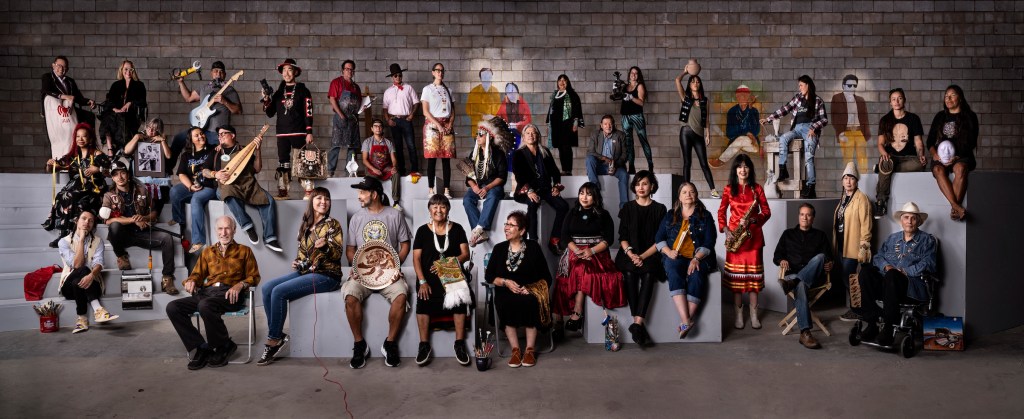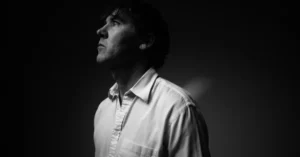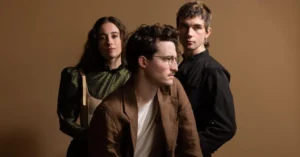The IAIA Museum of Contemporary Native Arts Is Weaving Indigenous Futures


America’s Cultural Treasures: This article is part of a series sponsored by the Ford Foundation highlighting the work of museums and organizations that have made a significant impact on the cultural landscape of the United States.
Some of my very favorite [teaching] units that I’ve facilitated with artworks have been here at MoCNA, being able to talk about the things that we need to talk about as humans right now: social justice, the environment, identity, stuff that young people are hungry for.
Lucy Ranney, Lead Teaching Artist, ArtWorks Santa Fe
Rose B. Simpson (Santa Clara Pueblo), a distinguished contemporary artist, talks about the difference between her experiences at schools where Native students were significantly underrepresented and Santa Fe’s Institute of American Indian Arts (IAIA). She describes her time earning a master’s degree at one institution as “horrible” and “unreal.” “I had to learn to communicate with some of the most uninformed and unconscious and insensitive, racist people you could imagine,” she explains.
After spending that time in that wilderness, Simpson returned home to New Mexico to find aspects of herself she had been missing by enrolling in a master’s program at IAIA, where she is now an alumna and trustee.
“The reason that I returned to IAIA… is there is a freedom in being in a roomful of Native creatives. When you’re in a space where you’re constantly having to explain your identity to other people, your growth is limited,” she says. “I returned to IAIA specifically to give myself sort of a break so that I could focus on who I was and what my expression looks like, rather than my Native identity, because you’re in a peer group of Native people who have a similar experience.”

The IAIA Museum of Contemporary Native Arts (MoCNA) in Santa Fe comes out of this pedagogical thinking and conscientious artmaking that means to carve out a space for more expansive living. Across varied narratives about the United States — including art historical ones — Native and Indigenous People are frequently cast into a primeval past they are not allowed to escape. Against this grain of being pitied or idealized, championed or ignored, Native American artists have advocated for telling their own stories rather than being the subjects of someone else’s. The IAIA reveals the full range of creative expression that can emerge from conditions in which art students have the freedom to focus on understanding and manifesting their internal architecture instead of addressing a culture that is indifferent or actively hostile to them.
“What I constantly hear from students is that they feel like this is their community, like it’s home, like it’s a family,” says Jason Ordaz, the institution’s communications director. “I feel like we’re giving them a sense of pride, belonging. We’re giving them an education in contemporary Native art, and I think we are giving them each other.”

Birthed in 1962, IAIA seeks to provide Native and Indigenous People with the professional training and formal education in the arts that give them the tools to create their own narratives and, by extension, enhance their lives and thrive instead of merely surviving.
Native and Indigenous People have a particularly uneasy set of choices when it comes to operating in the nation’s arts and culture fields. Governmental policymakers have long used institutional education to forcibly assimilate Natives into the cultural mainstream. On the other hand, without systematized training and formal education, they are frequently excluded from key positions in the arts ecosystem that would enable them to tell Native and Indigenous stories, especially with the support of major institutions.
There has been a long-term trend of disinvestment in cultural institutions that celebrate, support, or even acknowledge communities that have been historically underserved, particularly communities of color. According to the Institute of Museum and Library Services (an independent federal agency that provides library grants, museum grants, policy development, and research), there are approximately 35,000 museums in the United States. Other sources indicate that about 300 Native American cultural museums exist, and an untold number of cultural centers. However, Anya Montiel, a curator at the Smithsonian’s National Museum of the American Indian, testifies that there are only 10 museums dedicated solely to Native arts. MoCNA is one of them.
The museum started out as a sales gallery and teaching space known as the IAIA Gallery in 1962, when the university began collecting and exhibiting student artwork. In 1971, the Institute hired Charles Daily, a trained museum professional who would go on to teach at the university for over three decades, as the director of the gallery, which he renamed the IAIA Museum. It wasn’t until 1992 that the museum moved from the Institute’s campus to the Santa Fe Federal Building downtown, where it still resides. In 2009, the name was changed once more to the IAIA Museum of Contemporary Native Arts and in 2020, it received accreditation from the American Alliance of Museums. From this position in the heart of Santa Fe’s tourist economy, the museum provides key opportunities for the deepening and expansion of its mission to “elevate contemporary Indigenous art through exhibitions, collections, programs, partnerships, and new research.”


When Lloyd “Kiva” New (Cherokee) and Dr. George Boyce co-founded the Institute of American Indian Arts, they had a vision for Native formal education that ran counter to the prevailing pressure to assimilate into mainstream culture. “The underlying philosophy of the program at the Institute is that unique cultural traditions can be honored and can be used creatively as a springboard to a meaningful and productive life,” New wrote in a 1969 report to the then-staff director for the Special US Senate Subcommittee on Indian Education, Adrian Parameter. He went on to discuss the ways in which the US government had failed in even their good faith attempts to improve the situation of his people because of a profound inability to see Native Americans, that is, to recognize their humanity, instead rooting education in “a policy of coercive acculturation, the premise being that the sooner the Indian was conditioned to abandon his ways and join the melting pot, the better off he would be.”
In Celebrating Difference: Fifty Years of Contemporary Native Arts at IAIA (2012), editor Ryan Flahive contextualizes the university’s establishment in the fraught history of the Bureau of Indian Affairs (BIA), which was constituted in 1824. Flahive explains that in the wake of the American government’s 1953 Relocation Act and “termination” policy, the Institute of American Indian Arts’s establishment “reflected the BIA philosophy of educating Indians to leave the reservation.” Theodore Jojola (Pueblo of Isleta), the director of the Indigenous Design and Planning Institute at the University of New Mexico, testifies in the same volume that the germinal seed of IAIA was summer art programs begun in 1960 at the University of Arizona, funded by the Rockefeller Foundation. After a recommendation by the Indian Arts and Crafts Board of the Department of the Interior, BIA facilitated the establishment of IAIA as an arts-related vocational academy for students aged 15 to 22. Flahive explains further that the school was originally intended to replace the arts program run by the Santa Fe Indian School, founded in 1885 with the explicit intention to forcibly assimilate Native children. New and other administrators, he explains, built IAIA’s curriculum on a principle of “cultural difference as the basis of free expression.”
This pedagogical approach was a way to synthesize two choices that, at the time, were framed as antithetical: to preserve Native values and worldviews, and to empower Native students to create art in a contemporary social, cultural, and political landscape that actively sought to either forget them or treat them and their artwork as bygone artifacts of a primitive past. According to MoCNA Curator of Collections Tatiana Lomahaftewa-Singer (Choctaw/Hopi), who has been with the museum for 31 years, New’s principle of free expression also constituted a radical aesthetic shift.

“IAIA students were encouraged to create works that reflected a contemporary, personal expression drawing inspiration from their own Native heritage, other world cultures, and American modern art movements, such as abstraction,” she explains. “This new educational model represented an intentional departure from the dominant style of Indian art practice, particularly the flat ‘Studio Style’ painting of the 1930s, developed at the Santa Fe Indian School under Dorothy Dunn.”
Dunn, a White American art educator who founded the boarding school’s arts program, exclusively taught and proliferated this style of painting among an entire generation of Native artists. Rooted in her conflation of Native art traditions into a single, fixed aesthetic, the paintings developed in this style appear two-dimensional, illustrative, and idealized, providing no temporal, spatial, or social context. Some might describe these scenes as “timeless,” but Elissa Wheeler, the museum store manager, sees the prevalence of this style now as pernicious, leaving little room for the full breadth of Indigenous artistry: “People are coming to Santa Fe to see the stereotypical noble Native on horseback with the sunset behind him.” Wayne Gaussoin (Diné, Picuris, and French Descent), the museum educator, describes this style as “the romanticized imagery Americans have been told by mainstream media and Disney and even history books.”
Jewelry, paintings, and tapestries that showcase these severely limiting views continue to be desirable to consumers, and thus financially advantageous to makers. According to the New Mexico Tourism Department, direct visitor tourism in 2023 generated $8.6 billion. It also indicates that for the city of Santa Fe, visitor spending generated an estimated $811 million in state and local tax revenue. As estimated by the tourism board, these figures make New Mexico the third-largest art market in the country, second only to New York and San Francisco. The largest contributor to this status is the Southwestern Association for Indian Arts’s (SWAIA) annual Indian Market. Ordaz attests that it is “the biggest [market] for Native and Indigenous People in the world.” SWAIA itself claims that over 100,000 people attend the Indian Market each year and generate more than “$160 million annually in revenues for artists and the community.”
While IAIA’s college and museum seek to support the financial health and well-being of its students, faculty, and staff, it also looks to help them thrive in other ways. The concern here is not only with gaining academic credentials that have purchase in the places outside of Native life, but with new ways of thinking and making. The key staff members of the Museum of Contemporary Native Arts are concerned with providing the tools that Natives can use to flourish. The starting point for them is education.


One of the most important opportunities the museum provides Native and Indigenous artists is the yearly show of work by students graduating with a bachelor’s degree in the Fine Arts. Gaussoin describes the exhibition as a “huge opportunity for students to show their work in a very recognized museum,” adding that he knows from experience that “it’s kind of challenging and daunting for art students, Native and non-Native, to get your work out there and seen.”
Simpson, who was one of the select artists chosen for the Whitney Museum of American Art’s biennial in 2024, recalls that MoCNA “was one of the first places where I showed my work. It’s one of the places that holds space for certain creative processes that other museums don’t necessarily have time or space for.”
“Most importantly, I understand that it’s right downtown, so lots of passersby will walk into the museum and see what’s going on there,” she continues. “For the student community, it’s also really important to see what’s going on there and the collections and the shows … to see yourselves in a professional space for the first time. It changes your pathways to what’s possible.”


Transitioning from the theoretical construct of an imagined museum exhibition in a classroom to an actual show, with all its attendant scholarly research and investigation and careful installation mechanics, is a major shift. To have the opportunity to present one’s work in a professional setting is a key part of this educational model, which, following New’s conviction, understands Native culture as the basis from which the artist can dive into their art practice and develop the legs to swim.
Another way MoCNA deepens and extends its mission is by facilitating the exchange of information outside of the precincts of the university. Patsy Phillips (Cherokee Nation), the director of the museum, discusses the profound effect that the Institute has had on facilitating a generational transfer of knowledge: “I’ve learned this firsthand, teaching, a lot of our students want to go back to their communities, and [if there isn’t a] community center or museum, they want to go back and establish one.”
Specialized knowledge won’t just pool in the institution, but proliferate into students’ communities. Felipe J. Estudillo Colón (Laguna Pueblo), the current IAIA provost, echoes Phillips and makes the link between Native Peoples’ past and future.
“Intergenerational transfer of knowledge [is] part of how Indigenous communities have sustained themselves for time immemorial, and it’s the seed on which a lot of the work we do here grows,” he reflects. “We dedicate ourselves not just to becoming professionals in our own right but to […] helping to pass on that knowledge and that information.”
This handover of knowledge doesn’t only occur between generations — it also happens, through MoCNA, across the divide of nation-states and geographies. At the helm of the museum, Phillips has embraced exhibiting international Indigenous artists who present work that has global significance. For example, the exhibition Exposure: Native Art and Political Ecology, which opened at the museum in August of 2021 and traveled to venues in Oklahoma and California, drew on experiences of Indigenous People in the United States, Australia, Greenland, Japan, Canada, and the Pacific Islands. As Phillips testifies in the exhibition catalog, Exposure was “the first international exhibition of its kind.”
“The artists included in Exposure offer critical, experiential, and emotional analyses of the nuclear story and reveal the absence of Indigenous voices in the official narrative, which has been dominated by settler colonialism,” she writes.

In these ways, MoCNA demonstrates that Indigenous artistry is wider and deeper than is sometimes understood, because it ripples out into the ocean of the world.
At the same time, the museum is rooted here in North America and takes seriously its responsibility to the current generation of Native Americans. Felipe Colón explains that this duty extends beyond the mere preservation of Native culture.
“The average museum, they collect; they interpret; they display. It’s about preserving a moment in time, preserving an object. It’s about preserving a perspective, but what’s unique about MoCNA, about IAIA, is that we are also charged with perpetuating,” he says. “So, we take out what we created for this [exhibition], incorporate it into the curriculum, teach it to the next generation of artists and Indigenous artists and cultural practitioners so that they can then embody that and continue to pass that on.”
This is not a collection of static traditions frozen in time, but rather living, evolving cultures that are constructing and revealing their relevance with every Indigenous work of art displayed in the museum’s galleries.
One way to tell the origin story of the United States of America is to begin with the experiences of Native People. In fact, this is the necessary place to start. As Tony Abeyta, a Navajo Diné artist who graduated from IAIA and now lives and works in Santa Fe part-time, attests, “American Indian art is really part of the American art story. […] It’s been marginalized and put into the category of some kind of cultural story that people can’t identify with, or don’t understand. And yet, there’s these great parts about our story that happened hundreds and thousands of years before colonial contact, before borders, before urban sprawl, before all of that.”
To hold the past in cautious respect while understanding that it must not fully determine a community’s life chances requires skillful handling. This is the work accomplished by the Museum of Contemporary Native Arts. Like a tapestry fashioned by both tradition and innovation, it weaves together Natives across generations and widespread geographies, the hundreds of nations, communities, and tribes and distinct languages they speak. By nurturing successive generations of artists, MoCNA helps to add color and value, form and depth to the still-emerging image of Native and Indigenous life.
This article is licensed under a Creative Commons Attribution 4.0 International license.





